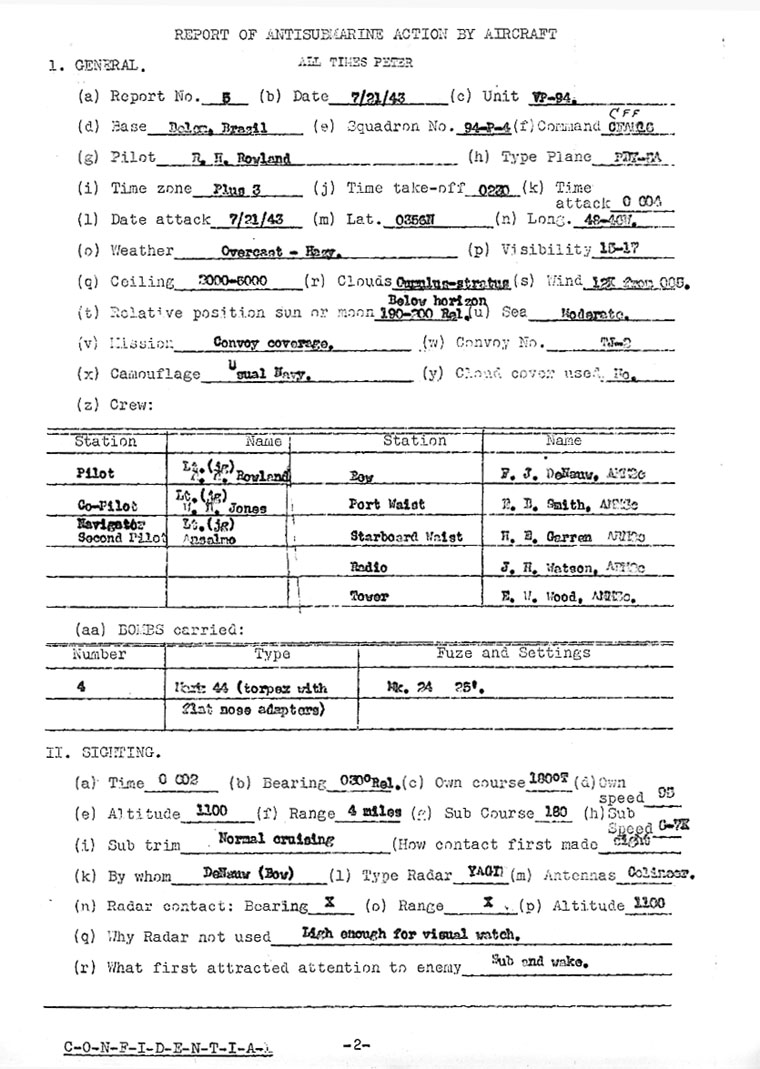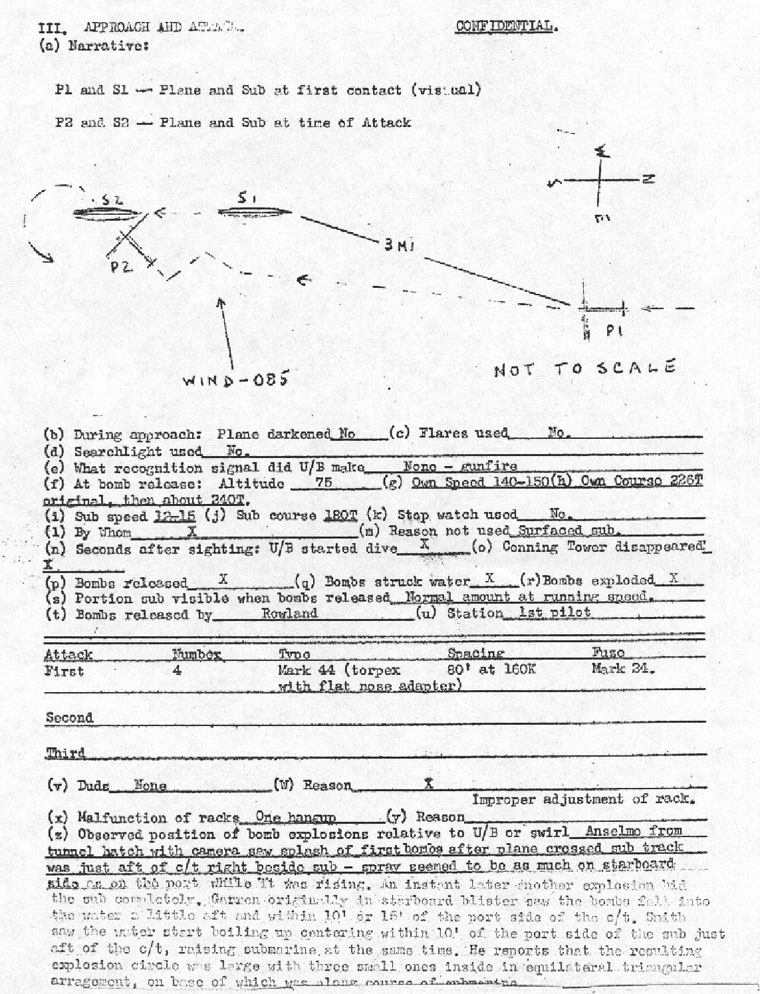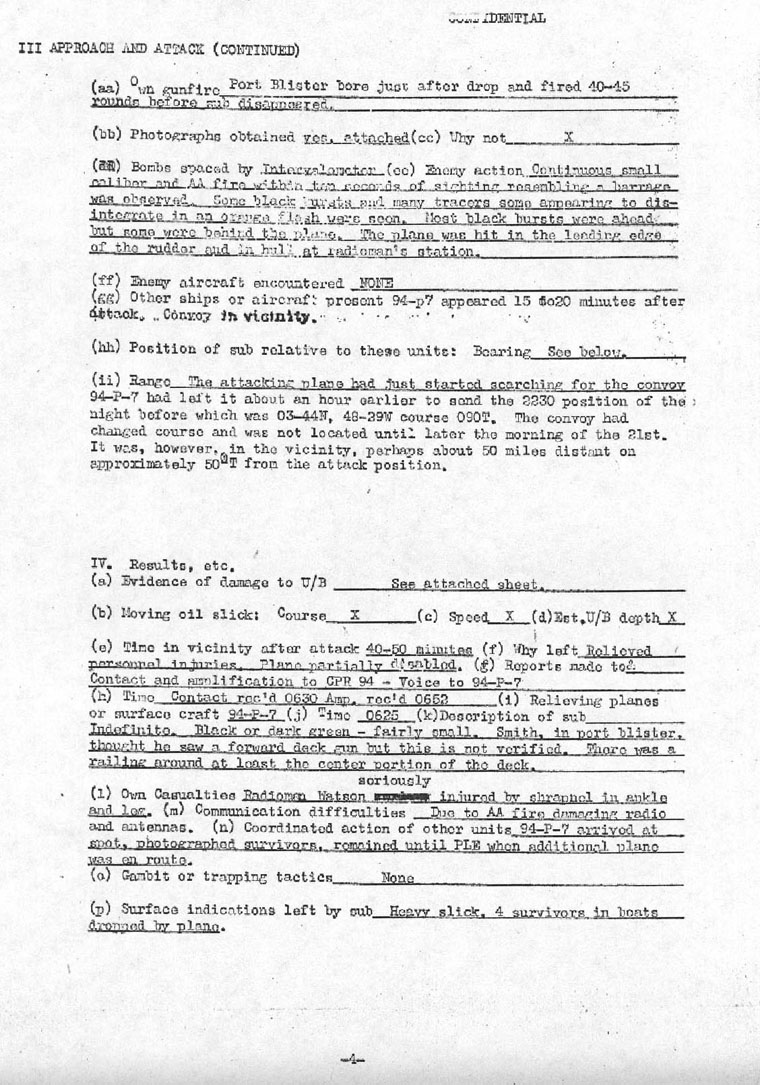



| CONFIDENTIAL | ||
NARRATIVE |
||
| At 0230P, July 21, 1943 94-P-4 took off from Belem to relieve 94-P-7 on coverage of TJ-2, then about 300 miles from the plane's base. The plane arrived in the area and started a search for the convoy at about 0530. | ||
| At 0602, four minutes after turning to course 180T, a submarine was sighted at 03-56N, 48-46W by the bow watch DeNauw, relative bearing 030, distance two to three miles. The submarine was colored grey green with brown camouflage markings. It was moving on course 180T paralleling the plane's course at a speed of 5 to 7 knots. The deck appeared to be slightly awash with little wake showing. The plane was flying at an altitude of 1200' with an IAS of 95K. Immediately after the bow station's sighting, co-pilot, Lt. (jg) Jones, in the second pilot's seat picked up the visual contact, definitely confirming the bow's finding. PPC Lt. (jg) R. H. Rowland, rolled the ship slightly to bring the sub into view. The pilot's bombing switch was then closed, and the warning horn blown. Second pilot Lt. (jg) Anselmo manned the camera at the tunnel hatch and later at the port blister. | ||
| The bow watch went into action to prepare the .30 cal. gun, but he was unsuccessful in freeing the barrel group to allow the breech lock to disengage. The bow gun was not cleared throughout the run. The pilot immediately turned to attack, but seeing the trouble with the bow gun, and encountering heavy anti-aircraft fire veered slightly to port for a short period of approximately five seconds, then started a shallow diving run. Gunfire from the sub was persistent, forming a heavy barrage, lying two thirds of the distance from the sub to the plane with some projectiles apparently disintegrating at that pont. Others came through to meet the plane and exploded on contact. The rudder fin was hit at the base during final turn. A shrapnel shot was received at the chine of the hull at the radioman's station, when the plane was approximately one mile from the submarine. The path of this shot could be followed by tracer, and the ensuing explosion heard upon contact. Radioman Watson suffered lower leg and ankle injuries from this shot, but managed to pull himself to the blister and ask Garren to relieve him. | ||
| The run itself was routine, in that the pilot successfully tried to approximate the condition with which he had become familiar in practice bombing hops. Final course was 225T, speed 140 to 150K. An auto-rich mixture with power setting at 30 inches and 2300 RPM was used throughout the run. The sun's glow was approximately 1900 - 2000 relative to the plane's heading. The submarine remained on its original course with the same speed and running condition. Fire from the sub ceased just prior to the drop. At the time of drop from an altitude of about 75', Lt. (jg) Jones was able to view the conning tower close by to starboard. Lt. (jg) Rowland pressed the pickle, but the inboard starboard hung-up. Intervalometer setting for this drop was 80' at 160K. From reports of the crew, it seems that charges #1 and #2 landed so close that they exploded almost under port side just aft of the conning tower. During a shallow pull-out and turn to port, the bow of the submarine was seen by the PPC to be emerging from the geysers of water at a sharp angle. | ||
| The port gunner and the tower watch could both see the two port bombs enter the water and viewed the start of the explosions. Their account is clear and their story apparently accurate so that despite the use of the intervalometer, the spacing of the drop would seem to be less than the setting used. A slower speed than that for which the intervalometer was set would account in part for the proximity of the first two explosions. The starboard bomb was observed to drop to starboard of and ahead of the bow of the submarine at a distance judged to be about 30'. | ||
| The port gun was brought to bear and a full can was fired in long bursts. The pilot continued the turn for approximately one minute in order to remain in the immediate vicinity. Lt. (jg) Anselmo observed the sinking of the sub while the plane was in this turn at nearly 900 to release course. | ||
| Upon re-establishing sight contact with the spot, the pilot saw no submarine, but in its place an oval oil patch which increased in size to 200 yards in length and 150 - 175 width. Some brown streaks running through the oil darkened area were observed by the crew. | ||
| The longer axis of the oval crossed the sub's former course at approximately 90, probably because of the wind. Coming back over the dropping point for the first time, a definite circular slick could be seen in the middle of the increasing pool of oil. Whether or not this was a welling of oil is unconfirmed in the pilot's opinion. | ||
| The amplification report was prepared and sent blind to base although it appeared at that time that the G09 transmitter was out of commission as a result of the sub's fire. The CW receivers were not working, and it was impossible to tell whether the message was received. The flat top antenna was carried away, and the trailing antenna was temporarily out of use. | ||
- 1 - |
||
(page two of the narrative is missing)
CONFIDENTIAL |
||||||||||||||||||||||||||||||||||||||||||||||||||||||||||||||||||||||||||||||||||||||||||||||||||||||||||||||||||||||||||||||||||||||||||||||||||||||||||||||
CHRONOLOGY OF OPERATIONAL ACTIVITIES AT VP-94 BELEM, BRAZIL JULY 19 - JULY 21, 1943. |
||||||||||||||||||||||||||||||||||||||||||||||||||||||||||||||||||||||||||||||||||||||||||||||||||||||||||||||||||||||||||||||||||||||||||||||||||||||||||||||
THE DATE GROUPS OF MESSAGES (M) ARE ZEBRA TIME; OPERTIONAL FLIGHTS (O) ARE PETER TIME |
||||||||||||||||||||||||||||||||||||||||||||||||||||||||||||||||||||||||||||||||||||||||||||||||||||||||||||||||||||||||||||||||||||||||||||||||||||||||||||||
|
||||||||||||||||||||||||||||||||||||||||||||||||||||||||||||||||||||||||||||||||||||||||||||||||||||||||||||||||||||||||||||||||||||||||||||||||||||||||||||||
- 1 - |
||||||||||||||||||||||||||||||||||||||||||||||||||||||||||||||||||||||||||||||||||||||||||||||||||||||||||||||||||||||||||||||||||||||||||||||||||||||||||||||
CONFIDENTIAL |
||||||||||||||||||||||||||||||||||||||||||||||||||||||||||||||||||||||||||||||||||||||||||
CHRONOLOGY OF OPERATIONAL ACTIVITIES AT VP-94 BELEM, BRAZIL JULY 19 - JULY 21, 1943. |
||||||||||||||||||||||||||||||||||||||||||||||||||||||||||||||||||||||||||||||||||||||||||
THE DATE GROUPS OF MESSAGES (M) ARE ZEBRA TIME; OPERTIONAL FLIGHTS (O) ARE PETER TIME |
||||||||||||||||||||||||||||||||||||||||||||||||||||||||||||||||||||||||||||||||||||||||||
|
||||||||||||||||||||||||||||||||||||||||||||||||||||||||||||||||||||||||||||||||||||||||||
(COVERAGE ON JT-1 WAS FINISHED 1200P 21st AND COVERAGE ON TJ-22 WAS FINISHED WITHOUT INCIDENT ON JULY 23rd.) |
||||||||||||||||||||||||||||||||||||||||||||||||||||||||||||||||||||||||||||||||||||||||||
C O N F I D E N T I A L |
||||||||||||||||||||||||||||||||||||||
COMMANDING OFFICER'S COMMENTS ON ATTACKS IN GENERAL |
||||||||||||||||||||||||||||||||||||||
1. Comments on each separate attack have been previously submitted. The following comments will be based in general on the following sightings and attacks as a group: |
||||||||||||||||||||||||||||||||||||||
|
||||||||||||||||||||||||||||||||||||||
2. All of those attacks were characterized by similar tactics on the part of the submarine--the definite decision to stay on the surface and shoot it out. All six attacks were made on fully surfaced submarines. Four of the six attacks met enemy fire. Of the remaining two attacks, one was apparently a complete surprise and the other was made during darkness. |
||||||||||||||||||||||||||||||||||||||
3. Undoubtedly the submarines have received definite orders to remain surfaced and use their guns. In the past 15 days the submarines, using these tactics, have slightly damaged four planes--none completely out of commission--killed one officer pilot, and wounded one radioman. In return, during the same period, these tactics have afforded the planes the opportunity to make nine sightings, six of which resulted in attacks giving three possible sinkings. Our reaction is that the decision to stay surfaced and shoot it out is hard on submarines. We hope that the submarines maintain their present tactics. |
||||||||||||||||||||||||||||||||||||||
4. The enemy fire encountered in these attacks is of a different type than my knowledge had led me to expect. There was little or no anti-aircraft fire from guns approximating 4" or 5" size. No large black or white bursts were seen. Tracers from smaller caliber guns were seen, and in each case small explosive bursts were seen well in front of the plane as well as close around the plane at various distances during the approach. Three planes were hit by bullets which exploded on impact about one foot after passing through the metal skin or fabric of the plane. After talking to the plane personnel, it is my opinion that the bullets used are slightly larger than .50 cal., come with or without tracer, explode slightly after contact, and also have a variable time fused explosion. Either the shells are filled with small shrapnel or else the body breaks up into shrapnel. I believe that these bullets can be set to explode at a given distance thus giving a barrage effect for an incoming plane. Once the plane reaches the barrage, the bullets then will explode upon contact. Probably the submarines have two of these rapid fire guns, one set for a close barrage, and the other to reach way out for the attacking plane before it reaches the barrage. These guns are mounted in or near the conning tower. The pictures of submarines in these attacks show a new type of submarine with a shielded gun aft of the conning tower. Evidently this type of submarine has orders to use its new armament against airplanes on the surface. |
||||||||||||||||||||||||||||||||||||||
5. The three attacks which resulted in probable sinkings were all characterized by the same post-explosion action. The submarines were fully surfaced with personnel on deck at the time of the drop. The spray from the explosion completely hid the submarine. When the spray subsided the submarine was in one case completely gone, and in the other two cases only a small section of the bow was visible going straight down fast. In no case did more than twn seconds elapse from the time of the explosion to the time of the submarine's disappearance. Either the submarines have a new submergence technique, or else their skins are thinner. |
||||||||||||||||||||||||||||||||||||||
C O N F I D E N T I A L |
||
Page 2. |
||
COMMANDING OFFICER'S COMMENTS ON ATTACKS IN GENERAL (CONT'D) |
||
6. All but three of the nine sightings in the past two weeks have been made by the bow lookout who stands erect, head exposed, wearing helmet and goggles. Of the remaining three sightings, one was made by a pilot and the other two by radar at night. The lookout assignment in the planes of this squadron is bow lookout, pilots and tower. Any extra lookouts are placed in the blisters, but they are secondary and optional. The bow lookout is mandatory. |
||
7. It has been proved essential to have the planes on station for escort duty well before daylight when night coverage has not been in effect, and also to be certain that the plane remains on duty until well after dark. While this has certainly for some time been the ordered in existence for daylight coverage, the practice in general has been to arrive about daylight and leave about dark, more or less. |
||
8. It is interesting to note that planes on convoy coverage have made six sightings which resulted in three attacks and one probable sinking. Sweeps gave two sightings which resulted in two attacks with one probable sinking. A plane in transit to a convoy made a sighting which resulted in an attack and a probable sinking. It would seem from this that convoy coverage was more productive of sighting than sweeps. In most cases, however, the escorting plane found the submarine at a greater distance from the convoy than his escort plan normally would permit. If the planes had kept to the regular escort plan the entire time, the submarines would undoubtedly have shadowed the convoy during the day and caught up at night. |
||
9. The submarine commanders must have excellent intelligence. Their concentrations were not only on the convoy routes but were also timed to be in the area where two oppositely bound convoys were due to pass. Apparently the subs lie quite a distance offshore, moving in only when the convoys approach. |
||
10. Convoy coverage is productive of submarine contacts only, naturally, when the convoy passes through submarine areas. Definitely, the planes should always go to the submarines. When the submarines head for the convoys, the planes should proceed them. When the submarines leave the convoys for other areas, the planes should follow them. |
||
11. The submarines undoubtedly have figured out the weaknesses of our present system of convoy escort plans and have commenced tactics to take advantage of those weaknesses. In these waters, for instance, the visibility is unusually good in good weather. The present escort plane is designed to prevent the submarine from closing in to attack the convoy while coverage is in effect. It also would prevent a submarine from coming in close enough on the surface, to sight and track the convoy from ahead or from the sides. It is not designed, however, to prevent the submarine from following the convoy during the day, tracking the smoke sightings from a distance astern greater than the escort plan carries the plane, and then overtaking the convoy during the night. Visibility of the convoy from the submarine is just as good from astern as from ahead, and the escort plan allows the submarine to come closer astern than ahead of the convoy. The submarine is content to trail astern during the day and attack during the night. Therefore a new escort plan should be designed not only to prevent a submarine from attacking during the escorting, but also to prevent the submarine from tracking during the escorting. This command is compromising at present by using the escort plan during the day until four hours prior to dark and sweeping astern, to the sides, ahead and then lastly astern again just prior to dark. In my opinion it is better to take a chance on the submarine attacking during the late afternoon and sweep to prevent him tracking for a sure attack during the night. When a convoy is passing through a threatened area and planes are available, the escort plan is continued till dark while a second plane sweeps at a greater distance from the convoy. |
||
C O N F I D E N T I A L |
||
Page 3. |
||
COMMANDING OFFICER'S COMMENTS ON ATTACKS IN GENERAL (CONT'D) |
||
| 12. Airplane deficiencies were apparent in these attacks. Several of the attacks were made at speeds close to 200 knots. At this speed the bow gun becomes unmanageable because of the wind on the gun and gunner. If the bow gunner can shoot, the maximum number of rounds available on these planes is 100, the capacity of each pan. The entire armor installation on these planes is designed for protection from the rear. With the impact-shrapnel type of bullet the submarines are using, enemy fire from ahead into rear armor means certain shrapnel explosions in the exact area the armor is designed to protect. | ||
| 13. The radar carried by these planes may be detected by the submarines. An improved type of radar is available. Our planes are now rotating for overhaul at Norfolk. So far they have all returned with the same radar that they took up North. | ||
| |
||
| J. B. TIBBETS, | ||
| Lieut. Comdr. USN, | ||
| Commanding. | ||